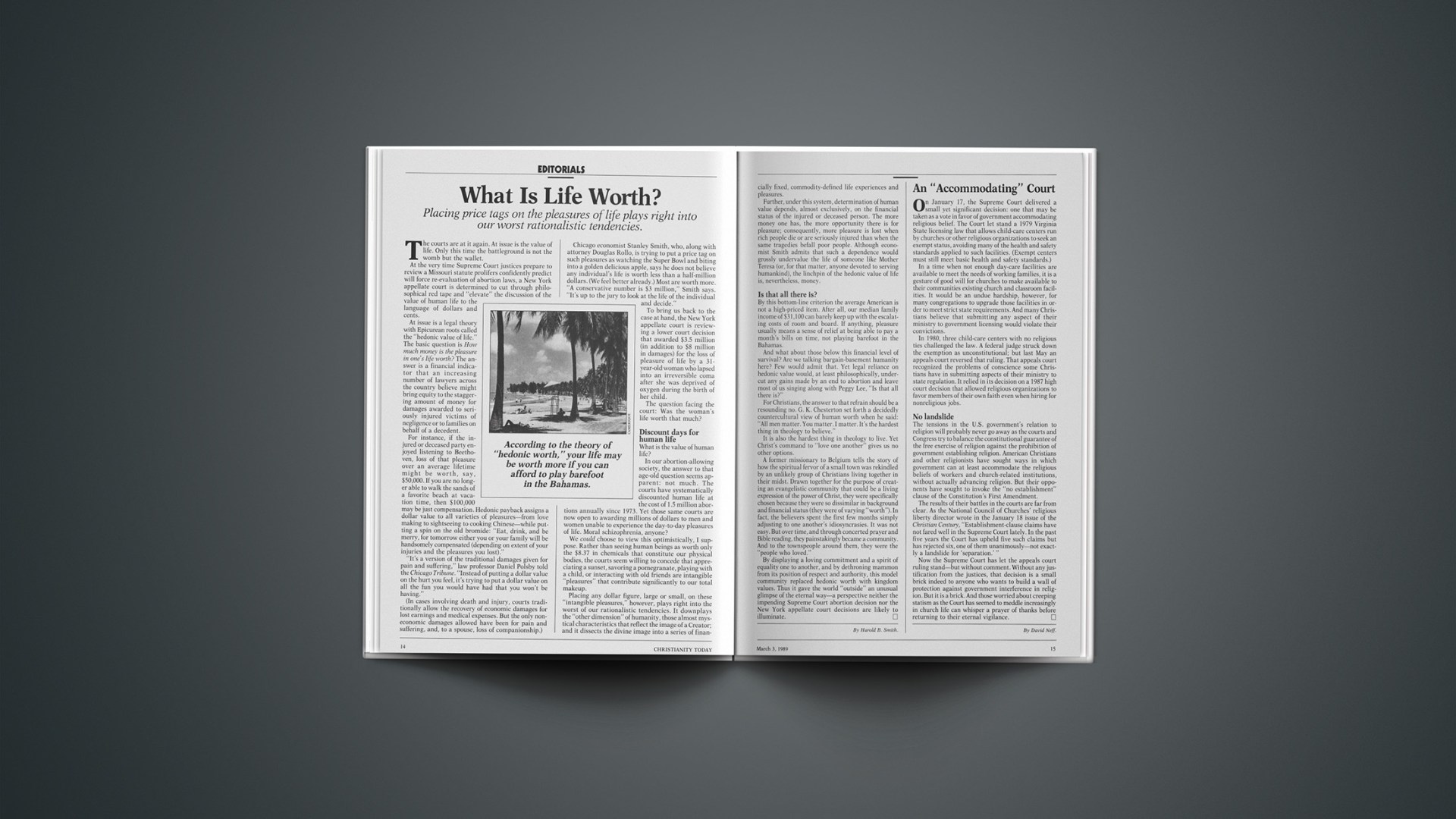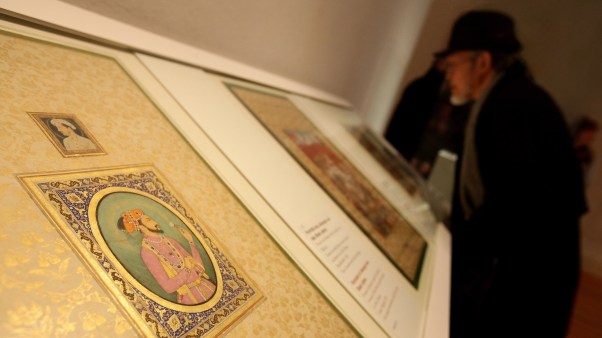Years ago, a man telephoned World Vision, the Christian relief organization, to complain. He wasn’t going to give any more money, he said, because Roberta Hestenes (pronounced HESS-ten-ess), a woman, sat on the board. The World Vision worker on the line told the caller that he should be glad for her presence; she was a dedicated worker who would make certain his money was well spent.
“I don’t mind a woman doing the work,” the caller replied. “I just don’t want one to have the position.” Thus he defined one version of the traditional evangelical view of women, and in so doing he characterized as well Roberta Hestenes’s pioneer status in the evangelical world.
Women have always had influence in the church, as mothers and teachers, models and encouragers. They have always “done the work.” But rarely, if ever, have they been given formal power in evangelical institutions. At 49, Hestenes has such power. As president of Eastern College in St. Davids, Pennsylvania, she is the first woman in that position among the schools of the evangelical Christian College Coalition. As the activist chairman of World Vision, she exerts power in one of the largest parachurch organizations in the world. She is a sought-after speaker and teacher.
“Powerful,” Hestenes says. “I’ve had quite a bit of feedback recently using that word. For a woman to be told, ‘You are powerful,’ is almost an insult.” Hestenes says she has a hard time thinking of herself that way. “I keep saying, ‘Who, me?’ ”
“A Forever Moment”
Roberta Louis was conceived out of wedlock by a bright 17-year-old boy and a stunning 16-year-old girl, both of whom dropped out of high school and were married to have the baby. They brought her home to a garage, with a sheet hung up to mark off the bedroom, and never quite forgave her for their disappointed hopes.
“My mother and father made very clear to me throughout my whole life with them that they did not love me. My father would say, ‘You were a beautiful baby; I don’t know what happened.’
“My father was an alcoholic. I probably never saw him sober. He made his living as a masonry contractor, but we ways kept the shades drawn to evade bill collectors. We argued in our family, every night at the table. Any positive affirmation was couched in sarcasm. Until the sixth grade, we children were disciplined with leather belts and coat hangers. My aunt tells me, ‘I watched you, and you were a bright little thing. I watched you use your brains to get out of there.’ ”
Education was the escape hatch. In high school Hestenes won prizes giving speeches. Eventually she won a scholarship to attend nearby Whittier College, intending to become a lawyer, and hoping for a whole new life.
Though her family was irreligious, “Louie,” as her college friends called her, was an earnest seeker who was elected president of the school’s Lutheran student group. She had long talks about God with the group faculty adviser, Ray Lentzsch. The college chapel offered a series of talks portraying the varieties of Christianity: liberalism, fundamentalism, and so on. She decided she was a liberal.
Then, on the first day back on campus after Christmas vacation, Lentzsch said that he needed to see her urgently. They met in a classroom, where he asked her, “Do you know Jesus?”
“In what seemed a forever moment,” Hestenes said, “I thought, I don’t know what he’s talking about, but the right answer to this question is yes. So I said yes.”
Lentzsch went on to describe his dramatic conversion over the holidays. He wanted Hestenes to go to church with him that night.
“I was staggered,” Hestenes recalls. “I spent that day thinking about what he’d told me.” She had saved six dollars to have her hair done, a rare treat. Instead she walked to a bookstore and used the money to buy a Bible. “All that day I knew something was going on inside of me.”
That evening Lentzsch took her to Grenada Heights Friends, a small, evangelical Quaker church. After the service they went to the home of Robert Seelye, a local businessman. Seelye began to talk to Hestenes about Christ. “While he was talking, his voice going on, I found myself praying and saying, ‘God, if you want to know me, and you can be personal, show me.’ Twenty minutes later Robert said to me, ‘Are you prepared to ask Christ into your heart?’ I said, ‘I already have.’ ” The time was 10:47 P.M., January 2, 1958.
Seelye gave her the Navigators’ “B-rations”—a packet of four basic memory verses—and a book by James M. Gray, the past-president of Moody Bible Institute. “I took the book and the ‘B-rations’ home, and I woke up the next morning so full of joy I could hardly stand it. I was just changed. I read my Bible and every word leaped off the page. It was confirmation after confirmation: It’s true!”
Two days later she went to see Seelye again. She was then, as today, very direct. “Where do we start?” she asked. Every Sunday night she went to his home to study the Bible, and was regularly disciplined by the college for violating curfew. “I had the wonderful fortune,” she says, “of being personally discipled by a man on fire with Christ.” Together with Lentzsch and Seelye, she started a campus Bible study to which she brought her friends. Dozens were converted.
The college was aghast at their fundamentalist fervor and tried to stop it. One day Hestenes, who worked part-time in the college administration office, was given a notice to type: it was the dean’s official order outlawing all dorm Bible studies. When she told the Christian group, they began to pray ardently. That Sunday night the dean died unexpectedly.
Hestenes rarely tells the story, she says, because it is so easily misunderstood. But she remembers it as powerfully faith forming. “I don’t know what happened, but I know what we believed: that God had slain her for opposing the work of God.”
Seelye, his wife, and three young daughters became Hestenes’s substitute family. Grenada Heights Friends embraced her. (Her Lutheran Sunday school class was taken away when she led 16 of the sixth-grade boys to Christ; the pastor asked her never to return.) Right from the beginning she felt a classical sense of calling to full-time Christian service. And as Seelye puts it, thinking back, “Right from the beginning I could see the world was going to move. This girl was a dynamo.”
A Marriage Under Grace and Freedom
When Roberta Hestenes joined the staff of University Presbyterian Church in Seattle, she had three children under the age of six. How did she manage it all?
Part of the answer lies in favorable circumstances. Her husband, John, was a student with a flexible schedule, and he liked parenting. Roberta, too, could do much of her work at home. In addition, the church had just launched a Head Start program, enabling her to leave her two toddlers just down the hall from her office.
“I regret,” Hestenes says, “that our culture has shifted to the place where it does not seem to affirm the value of the mother who chooses to remain at home with her children. There’s nothing particularly praiseworthy about selling necklaces at Penney’s or writing memos in an office, over against the opportunity to shape a life, to build values, to show love. I did what I did because God called me, not because I had a career track.
“But if a woman has gifts that are to be used for a broader family, she’s sinful if she doesn’t use them. They’re given for the common good. They should not be used at the expense of her children. But I found I had energy left over after caring for my children—plenty of it. It wasn’t ‘either/or.’ ”
Surely this would have been impossible without John. “He says that he has never struggled with my ministry. He believes in it. He has never in 29 years said anything negative or hostile about it. He will come to church especially to hear me preach, because he says God blesses him through it.”
Since living in Seattle, the Hesteneses have moved twice: once for Roberta to teach at Fuller Theological Seminary, more recently to enable her to become president of Eastern College. Both times John fit his career into hers, making the move when he did not yet have a job in the new location.
Wimp or wonder husband?
Roberta says that people tend to project one of two images on John: either he’s a wimp, or he’s a wonder husband. Meeting John dispels the first possibility quickly: he is a distinguished research scientist working on the frontiers of biophysics, with a particular interest in the functioning of the brain. In Pasadena he worked at Cal Tech’s Jet Propulsion Laboratory; in Philadelphia he is a professor at Drexel University. He considers it part of his ministry to facilitate Roberta’s work, but that does not mean he would rather talk about it than his own research. He grows visibly animated when discussing his arcane specialities (his resume lists these as superconductivity, neuromagnetometry, evoked potentials, neural net computers, ultrasound, and gallium arsenide gigahertz signal processing).
On the other hand, the Hesteneses have no miracle marriage. Roberta is frank to say that their personalities differ, that they have to work at communication, and that they have had conflict in their marriage—serious conflict at two different points. At one time they sought therapy, which they found extremely helpful.
“God broke the cycle of evil in my family with my conversion,” Roberta says, referring to her troubled upbringing. “God put his hand on my family to begin a new chapter.”
While her responsibilities have brought increased loneliness, she draws heavily on her husband and children. All are active Christians. Her oldest daughter, Joan, with her husband and their child, share the Eastern president’s mansion while they attend graduate school. Roberta’s family is part of the newness God began at her conversion, and explains why she has little use for an “organizational-chart” view of marriage. “Every marriage has its own uniqueness,” she says. “You don’t live in the marriage by rules or by law. You live under grace and freedom.”
Faded Dreams
“I wanted more than anything else,” Hestenes says, “to serve Christ, to win people to Christ, to teach people about Christ. The classical way you did that, as a Christian woman, was you found a Christian man who would commit to full-time Christian service, and you married him.”
A few months after her conversion, she met John Hestenes at an Inter-Varsity Christian Fellowship training conference. A physics student at the University of California in Santa Barbara, and a lifelong Lutheran, he had recently been converted through a process that began while he was mountaineering in the Swiss Alps. Like Roberta, he was an officer of his campus Lutheran group.
By August they were engaged; on September 18, 1959, just over a year later, they married. Planning to become a missionary in Latin America, John began school at Fuller Theological Seminary. Though Roberta was in her junior year at Whittier, she dropped out to attend the more interesting courses a student wife could audit at Fuller.
But soon conversations with the Latin America Mission were growing uncertain. Mission authorities could not imagine John, a quiet man, as the type needed for their evangelistic work. Perhaps he might teach in a Latin university. To prepare for such a career, the Hesteneses moved to U.C. Santa Barbara, where John pursued a master’s degree in nuclear physics, and Roberta finished her undergraduate degree in Hispanic history and culture. They graduated together in 1963, accompanied by two new Hesteneses: two-year-old Joan and two-month-old Eric. John went on to teach physics at California Lutheran College, and found that he liked teaching. It was a familiar world; John’s father was chairman of the UCLA math department.
Their third child, Stephen, was born. Roberta was busy raising small children and serving in their church and community. The dream of full-time missionary service was fading. Finally, after many long conversations with the Hesteneses, the Latin America Mission said they could see no role for John.
“Something died in me,” Roberta says. “I felt John had been disobedient to God, and he had to bear the burden of my disapproval. I was a submissive wife, I didn’t try to talk him into something else, but in my heart of hearts I felt that if he were a first-class Christian, he would have gone into full-time Christian work.”
It was more than that, of course. John’s decision seemed to limit her response to God’s call. In the early 1960s, a woman could do only so much in America. Hestenes says she was happy raising children and actively volunteering. She had no other ambitions for herself. But the life she had discovered as a new Christian, a life of nonstop, energetic, make-it-happen faith—that life seemed about to slip away.
Robert Munger, a well-known, saintly figure among West Coast Presbyterians, remembers nothing striking in his first encounter with Roberta Hestenes. The University Presbyterian Church in Seattle where he pastored was launching the Bethel Series Bible study; he was recruiting teacher-trainees. He had heard from a friend about John Hestenes, so he invited him to join the training course.
John asked if he and Roberta could train together, since his work as a Ph.D. candidate at the University of Washington absorbed so much family time. Munger initially thought not; he had enough women teachers. But when the Hesteneses stood firm, Munger relented, and even found an elderly woman to watch their three small children. When she was invited to join, Roberta began to weep. “I knew in my spirit that this was a very significant thing. I didn’t know why.”
The pastor soon did. “She had not been in the class two times before I knew she was something special.” She plunged into the study, a two-year survey of the Bible, with enormous enthusiasm. Says Roberta: “I read ten books a week. I wrestled with every tough issue.”
Munger, she says, was a magnificent teacher. He was also a man completely unthreatened by her abilities. Henrietta Mears had been responsible for his faith, and her ministry had been a powerful model during his early years as a pastor (see “In the Footsteps of a Grand Vision,” below). He had no difficulty appreciating a powerful woman. So he appointed Roberta “practice teacher” when he went to a denominational meeting.
“I probably put 40 hours into preparation,” Hestenes says. She had led Bible studies, but never done a stand-up, two-hour lecture to a group that included university professors and church elders. The response was overwhelmingly affirmative: the class petitioned Munger to have her teach whenever he was absent. And Munger was often absent, increasingly so as the two years of study progressed. “People responded so strongly that even with my self-doubt, I could see that I had a gift,” Hestenes says. Toward the end of the second year, she took over teaching the class entirely.
Munger invited Hestenes to join the church staff part-time; a year later she became full-time director of adult education. She organized and taught Bible classes, neighborhood Bible studies, and seminars.
“The overwhelming experience in the church,” she says, “was one of unexpected and gracious encouragement. I would not be who I am if the pastor and people of that church had not loved me, wanted my ministry, subjected themselves to my ministry, and cheered for me. They opened every door and then pulled me through.”
This is why Hestenes’s feminism has never been angry. “If I’m honest with the facts, I don’t have much to be angry at. I have not been an angry woman pushing on doors that people wouldn’t let me go through. I’ve been a reluctant woman, and people have said, ‘Come and help.’ And I have said, ‘No, no, you can’t possibly mean me.’ They’ve said, ‘Yes we do,’ and when I got there they meant it. My theme has to be gratitude. I love Christian work. The opportunity to teach the Bible, to lead people to Christ, to build a group program—I have always been very, very grateful for that.”
In the Footsteps of a Grand Vision
“I was privileged to work with and for men who were products of the ministry of Henrietta Mears,” says Roberta Hestenes, explaining her early opportunities for ministry. “When they saw me coming, they had a category for me.”
It was quite a category. Mears’s Bible teaching was legendary in Southern California, but her disciples—her “boys”—remember something else about Mears.
“She was the most powerful person spiritually that I have ever known,” says Robert Munger. “She lived the life of the supernatural. But in a healthy way, a very human way.” Raymond Lindquist, the third senior pastor she worked with during her 35 years at First Presbyterian Church in Hollywood, remembers most “her almost incredible absorption in young people as separate persons.”
More than 300 graduates of her Sunday school college department went on to full-time Christian work. During a week at her Forest Home conference grounds, just before his famous 1949 Los Angeles crusade, Billy Graham resolved his personal doubts about the Bible and laid a foundation of faith that would transform his ministry. He later said Mears had influenced him more than any woman other than his mother and his wife.
Gaudy hats and a gravelly voice
Mears was born in 1890 in Fargo, North Dakota. Her banker father reportedly exclaimed at her birth: “Praise God, it’s a girl! I couldn’t face raising another son.” She taught high school chemistry in Minneapolis for ten years, and then in 1928 was lured to Hollywood’s First Presbyterian Church to become director of Christian education. She electrified the teachers; in just over two years the Sunday school grew from 400 to 4,000.
Discontented with existing curriculum, Mears wrote her own; lessons were written and mimeographed just in time for the next week’s lesson. That unheralded publishing venture launched Gospel Light, soon to become one of the largest independent publishers of Christian education materials. Mears also founded the Forest Home conference grounds, still a chief gathering place for Southern California Christians.
“Teacher,” as Mears was known, was famous for her gaudy hats and gravelly voice. She never married, joking that the apostle Paul had lived in another dispensation and she had never found a man to match him, “though I am still looking.” For the last decade of her life she lived in a recreated French castle located on one-and-a-quarter acres on Sunset Boulevard. Those who knew her said its grand style suited her vision.
Powerless
Hestenes became a fixture on her church staff, continuing after Munger left to teach at Fuller Seminary. She experienced the exhilarating sense that her ministry had no limits—in Seattle.
But outside Seattle, she began to realize, things could be different. John’s work would probably soon take him to another city, once he had his Ph.D. She lacked formal credentials in a denomination that reflexively looked to pastors—all men—for leadership.
While she was thinking about this, Hestenes attended the Celebration of Evangelism in Cincinnati, Ohio. Her senior pastor had been asked to do a seminar on singles’ ministry. He had asked her, as the person in charge of ministry to singles, to prepare an outline for him. She heard him give the workshop. She watched the virtually all-male platform. There seemed to be no place for a woman.
On a walk with Munger, she bared her soul. She told him she would be leaving the ministry and going to the university. She had already begun studying in the University of Washington speech department, considering a doctoral program.
Munger was surprised. “Why would you do that? Don’t you love the work?”
Hestenes tried to get across to him her sense of powerlessness when she looked beyond her immediate ministry. “Bob, you yourself don’t believe in the ordination of women.”
Munger is a spare man with a gentle, unprepossessing style. She remembers him saying, “I don’t know about that. But I believe in you. I want you to use your gifts on behalf of the church.”
“I heard that as a call from God.” Hestenes had practically stumbled into full-time ministry without counting costs, because there had seemed to be no costs. Ministry had seized her; the church had pulled her into its work. Now she realized that the ministry must also impel her. “I went back to the church committed to the church, not knowing how that was going to work out, but knowing that that’s what my call was.”
Since leaving Seattle, Munger had urged Hestenes to come to Fuller Seminary. She did not listen attentively. Fuller in her memory was an austere institution where classes began, “Gentlemen, …” even while she sat noticeably in the front row. Munger persevered, and in early 1974 she interviewed and was formally offered a job teaching communications.
John was sure she ought to go. His degree was complete, and he was ready to move on. But Roberta waffled. Fuller’s Paul Jewett had recently published Man As Male and Female, and stirred heated debate over women’s position in the church. She had no stomach for target practice, especially as she might be the target. She wondered whether Fuller really wanted a woman with no advanced degrees. Fuller persisted until she became convinced. In January 1975, she began to teach. John followed her, still looking for a job. (He eventually joined Pasadena’s prestigious Jet Propulsion Laboratory.)
She stayed at Fuller for 12 years, also serving as a part-time pastor at La Canada Presbyterian Church. Under Fuller’s broader umbrella, she emerged as a nationally known speaker, appreciated particularly for her expertise in small groups. She studied while teaching, completing her M.Div. and D.Min.; these led to her ordination in the Presbyterian church and her tenured status as faculty.
Hestenes made a mark at Fuller. Not content merely to teach communications, she helped invent a new major, something called Christian Formation and Discipleship. Within the name is an assertion: making disciples, not accumulating knowledge, should be at the heart of the seminary as well as the church. Of course, Hestenes was not the only one thinking such thoughts; the whole American church was talking about “spirituality.” But at Fuller she figured out the program, she fought for the budget, she provided energy and focus.
And she championed women in ministry. Fuller had women students when she came, but she became The Woman, who stood up for women’s concerns and held her own in faculty meetings. Though not an angry feminist, her direct speech made her a target, as she had feared. She also became, for some, a hero. Either way she was larger than life. The role was not easy on her.
Throughout her Christian life, involvement in small groups had given her a strong sense of belonging. With her family background, she needed to be loved and liked. But she was increasingly busy studying, teaching, raising teenagers, and attending meetings around the world. In 1980, she joined the World Vision board, doing extensive international travel. She eventually was asked to head the international board. That, with everything else, left little time for friendships. Her home was in an affluent neighborhood; she was a pastor rather than a peer to her fellow church members, and other faculty at Fuller did not always find her strong style easy to befriend. She was respected and appreciated, but not entirely liked.
“Before Fuller,” she says, “I was one of the group. I wasn’t ordained. My friends were women very much like me. They understood who I was and they saw my gifts. I did my ministry and did not feel separated. When I came to Fuller, I found a pedestal, and the pedestal has gotten lonelier and lonelier.”
While at Fuller, she fought endometrial cancer, postponing surgery until the day after her ordination. Three months of intensive radiation treatment followed. She remembers receiving over 450 letters; in that sense, the experience affirmed others’ love for her. Yet pain and fear are lonely. She remembers attending a Fuller faculty meeting after a six-month’s absence, thinking, “These people, how can they care about this stuff?”
“I felt the whole world was living on the surface and I was down in the depths, and I didn’t know how to express that. Who was interested, and who would listen?”
Two years after the surgery another tumor was found. Her doctor told her that such a recurrence was 100 percent fatal. She and John went away for a week together, saying good-bye. A biopsy was done, with surgery to follow. To everyone’s surprise the biopsy turned out nonmalignant. The surgeon wanted to go in anyway. Hestenes, in perhaps the bravest thing she ever did, said no. Seven years later she has experienced no further difficulty.
“Not A Maintainer”
When the position of provost came open at Fuller, some thought Hestenes considered herself the leading candidate. She denies the ambition, but admits she did want the ethos of Christian Formation and Discipleship to take over Fuller Seminary, something that a faculty member did not have the institutional levers to bring about.
She was not chosen, and she says she began to leave Fuller on the day the selection was announced. Fuller, in her view, had decided to stick to a traditional academic model, and would lose its fluidity and sense of adventure. “I am not a maintainer,” she says.
She looked for another institution to shape. John was ready to move on. Their children were out of the nest. Roberta considered a senior pastorate, and might have taken it if the church had not insisted that her World Vision commitments be scaled back. To the Hesteneses, World Vision seemed to fulfill their original missionary call; they did not want to give it up.
Then a small Baptist college near Philadelphia expressed interest. Hestenes had first encountered Eastern when she helped hire its president, Robert Seiple, as World Vision’s U.S. president. Now the school asked her to take his place. For the board, the fact that she was a woman seemed much less troubling than the fact that she was a Presbyterian. They wanted her leadership. After considerable deliberation, she accepted and, in September 1987, began a new career.
She began with characteristic energy. Shortly after she reached the campus she told the Philadelphia Inquirer about her vision of Eastern as “the place—in the world—that you would want to come” for an education with a Christian outlook in certain “helping professions.” She also spoke of the college becoming the “center of a world movement.” Particularly dear to her heart is an M.B.A. program that Eastern offers in Third World economic development.
But vision and reality are different, and Hestenes has not found the adjustment to being president altogether easy. “There’s a game I had played and hadn’t known it, a game called Blame the Boss,” she says. “One day I got ready to play Blame the Boss and I realized I was the boss.”
Hestenes immediately stirred controversy by refurbishing part of the student center for her new office. Not everyone felt the expense fit the image of a college operating with a tight budget and a commitment to economic development in the Third World. Hestenes, however, has no regrets; she says the old office was too small to allow her executive staff to sit in a circle.
If some Eastern people were less than delighted with her on second look, she was herself unsure how she liked her new role. She did not want to be a fund raiser, nor does she find it easy to reach out to strangers, to make small talk, to ask for help. John identified her frustration: it was her first real “job.” “Now you know how the rest of us feel,” he said.
Is Roberta Hestenes cut out to be a college president? It is difficult to imagine her ingratiating alumni or attending soccer games; she is more comfortable in a contest of ideas than a contest of remembering names. But even her critics would be surprised if she were to become mired in an institutional slough. They expect her to make a mark at Eastern, for however long she is there.
The reasons for thinking so reflect her gifts and determination, which are formidable, but more so the nature of her ambition. Like many people in the public eye, she longs to be admired and loved. But that is not her first principle. She lives for something much bigger than herself.
In fact, at every turning point of her life, when she would have found it easier to pursue her life with less evangelical conviction, she has chosen the narrower road. Her conversion pitted her against the ecclesiastical and educational powers, as well as a hostile family; she gave up a boyfriend who wanted to marry her, because he was not a Christian. She committed herself to the church when an easier career in secular academia offered itself. She devoted herself to transforming the spiritual climate at Fuller rather than fitting herself to the academic status quo. One can, of course, get strokes through such choices, and she did. But there are other, easier ways to get a reputation.
So far Hestenes is newsworthy mostly because of achievement: she is the first woman in evangelicalism to hold top positions. Yet her story is strikingly less a feminist tale than an evangelical one—a story less of finding herself than of being found, less of asserting her role than of being called to use her gifts.










